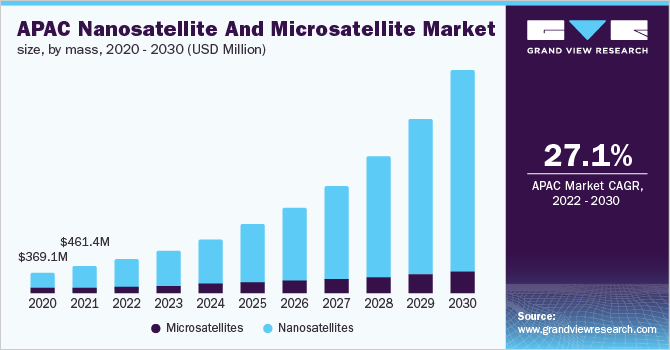Nanosatellite And Microsatellite Market Executive Summary, Dynamics, and Technology Overview 2030
Nanosatellite And Microsatellite Market Growth & Trends
The global nanosatellite and microsatellite market size is expected to reach USD 13.89 billion by 2030, growing at a CAGR of 23.3% from 2022 to 2030, according to a new report by Grand View Research, Inc. The upsurge in Earth observation missions and the development of Small Satellite Launch Vehicles (SSLVs) are expected to propel the growth of the market. For instance, in February 2022, EOS-04, an Earth observation satellite, was launched into a sun-synchronous polar orbit by India's Polar Satellite Launch Vehicle PSLV-C52. The satellite weighs 1,710 kg and provides high-quality photographs.
The emerging role of small satellites in the telecom sector has enabled telecom providers to accelerate 5G deployment globally, in addition to creating market opportunities for the satellite communication (Satcom) industry stakeholders. Developing small satellites for 5G deployment can particularly benefit in the form of wide-area coverage, cost-effectiveness, and reliability. Latest technologies such as new solar panel cell technology and star tracker technology are allowing providers of small satellites to strengthen their position in the broader satellite industry.
Gather more insights about the market drivers, restrains and growth of the Nanosatellite And Microsatellite Market

For instance, in January 2022, Sateliot, a nanosatellite and telecommunications operator based in Spain, signed a Memorandum of Understanding (MoU) with the European Space Agency, an intergovernmental organization of 22 member countries devoted to space exploration, to assess, develop, and enforce innovative products, technologies, and services with space capability using 5G. The company intends to invest approximately 100 million Euros in launching a fleet of 20 nanosatellites for 5G network design, mixed terrestrial space networks, spectrum exchange, and spectrum management.
The growth of the communications sector and the continued adoption of Internet of Things (IoT) are expected to create growth opportunities in the market. The continued adoption of IoT would particularly encourage start-ups to launch their small satellites. For instance, Hiber launched its first nanosatellite in 2019 to deliver internet connectivity to remote locations using a Hiberband modem and support potential IoT projects globally. In November 2021, Fleet Space Technologies Pty Ltd acquired USD 26 million in Series B funding to accelerate the development of its nanosatellite internet of things connectivity fleet.
The IoT nanosatellite fleet facilitates two-way communications in rural locations with inadequate mobile phone and broadband connectivity. Government support is the key factor encouraging companies to launch nanosatellites and microsatellites for communication and navigation, Earth observation, and remote sensing applications. However, frequent delays in satellite launches are leading to skepticism. Nevertheless, independent launch vehicles are being developed and low-cost sensors are being manufactured by the key companies, which is expected to help overcome the growth barriers.
Nanosatellite And Microsatellite Market Report Highlights
- The nanosatellites segment is expected to grow at a significant CAGR over the forecast period. The progression toward low-cost satellite-based internet services is enabling a transition toward the adoption of these satellites
- The Earth observation/remote sensing segment growth can be attributed to the development of low-mass and low-power navigation sensors for small satellites, which provides impetus to new remote sensing and Earth observation missions
- The civil segment is expected to grow at a CAGR of more than 24% over the forecast period as the commercialization of small satellites introduces academic institutions and research organizations to the space technology
- Asia Pacific is expected to emerge as the fastest-growing regional market over the forecast period owing to increased nanosatellite launches by various academic institutions and increased government support for developing space programs
Browse more reports published by Grand View Research.
- Finance And Accounting Business Process Outsourcing Market Size, Share & Trends Analysis Report By Services (Order-to-Cash, Procure-to-Pay, Record-to-Report), By Enterprise Size, By Vertical, By Region, And Segment Forecasts, 2024 - 2030
- Satellite Manufacturing Market Size, Share & Trends Analysis Report By Category, By Mass (Large Satellites, Medium-sized Satellites), By Type Of Business (Government, Commercial), By Application, By Region, And Segment Forecasts, 2024 - 2030
List of Key Players in the Nanosatellite and Microsatellite Market
- Dauria Aerospace
- GomSpace
- Innovative Solutions in Space (ISIS)
- Sierra Nevada Corporation (SNC)
- Spire Global, Inc.
- SpaceQuest Ltd.
- Surrey Satellite Technology Limited (SSTL)
- The Boeing Company
- Tyvak Inc.
- Vector Launch, Inc
About Grand View Research
Grand View Research is a full-time market research and consulting company registered in San Francisco, California. The company fully offers market reports, both customized and syndicates, based on intense data analysis. It also offers consulting services to business communities and academic institutions and helps them understand the global and business scenario to a significant extent. The company operates across multitude of domains such as Chemicals, Materials, Food and Beverages, Consumer Goods, Healthcare, and Information Technology to offer consulting services.
Explore Horizon, the world's most expansive market research database
Comments
Post a Comment